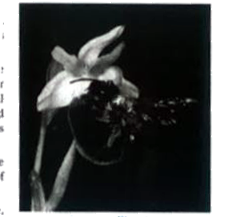Explain pollination by animals with examples in detail Solution in Gujrati
Some animals are also responsible for pollination. Bees, butterflies, flies, beetles, wasps, ants, moths, birds and (sunbirds and humming birds) and bats are the common pollinating agents. Among the animals, insects, particularly bees are the dominant biotic pollinating agents. Even larger animals such as some primates (lemurs), arboreal (tree dwelling) rodents, or even reptiles (gecko lizard and garden lizard) have also been reported as pollinators in some species. Often flowers of animals pollinated plants are specifically adapted for a particular species of animal. Majority of insect pollinated flowers are large, colourful, fragrant and rich in nectar. When the flowers are small, a number of flowers are clustered into an iflorescence to make them conspicuous. Animals are attracted to flowers by colour and/or fragrance. Flower pollinated by flies and beetles secrete foul odours to attract these animals. To sustain animals visits, the flowers have to provide rewards to the animals. Nectar and pollen grains are the usual floral rewards to the animals. For harvesting the rewards from the flower the animal visitor comes in contact with the anthers and the stigma. The body of the animals gets a coating of pollen grains.

The flowers pollinated by animals are generally sticky. When the animal carrying pollen on its body comes in contact with the stigma, it brings about pollination. In some species floral rewards are in providing safe places to lay eggs, an example is that of the tallest flower of Amorphophallus (The flower itself is about 6 feet in height). A similar relationship exists between a species of moth and the plant Yucca where both species-moth and the plant cannot complete their cycles without each other. The moth deposits its eggs in the locule of the ovary and the flower, in turn gets pollinated by the moth. The larvae of the moth come out of the eggs as the seeds start developing. (Note: observe the plants around you and observe animals visiting if and do study whether they are pollinators or not). Many insects use pollen grain and nectar without doing pollination. These floral visitors are referred to as pollen/nectar robbers
Topper's Solved these Questions
- BOOK - KUMAR PRAKASHANCHAPTER - SEXUAL REPRODUCTION IN FLOWERING PLANTSEXERCISE - Section -A (Double Fertilization)1videos
SEXUAL REPRODUCTION IN FLOWERING PLANTS
- BOOK - KUMAR PRAKASHANCHAPTER - SEXUAL REPRODUCTION IN FLOWERING PLANTSEXERCISE - Section -A (Post Fertillisation: Structures And Events)5videos
SEXUAL REPRODUCTION IN FLOWERING PLANTS
- BOOK - KUMAR PRAKASHANCHAPTER - SEXUAL REPRODUCTION IN FLOWERING PLANTSEXERCISE - Section -A (Flower-A Fascinating Organ of Angiosperms)3videos
SEXUAL REPRODUCTION IN FLOWERING PLANTS
- BOOK - KUMAR PRAKASHANCHAPTER - REPRODUCTIVE HEALTH EXERCISE - Section - F Multiple Choice Questions (MCQs)102videos
REPRODUCTIVE HEALTH
- BOOK - KUMAR PRAKASHANCHAPTER - STRATEGIES FOR ENHANCEMENT IN FOOD PRODUCTIONEXERCISE - SECTION -F (Multiple Choice Questions (MCQs)) (MCQs Asked In Competition Exam)63videos
STRATEGIES FOR ENHANCEMENT IN FOOD PRODUCTION
Similar Questions
Explain double fertilisation angiosperms
02:37View SolutionWhat is endosperm? Describe types of endosperm
01:51View SolutionMention social, religious and cultural value of the flowers
03:15View SolutionWhich problems arise due to uncontrolled population growth ?
06:07View SolutionPollen-grains of a plant whose 2n = 28 are cultured to get callus by tissue culture method. What would be the number of chromosomes in the cells of the callus?
05:49View Solutionस्वपरागण तथा पर-परागण में दो-दो अन्तर स्पष्ट कीजिए तथा एक-एक उदाहरण दीजिए |
03:06View SolutionExplain in detail the idea of weightlessness using lift as an example.
View SolutionWhat is pollination? Explain self pollination and cross pollination with examples.
View SolutionExplain stordiometry in detail with examples.
04:46View Solutionरेडॉक्स अभिक्रिया को उदाहरण सहित स्पष्ट कीजिए। ऑक्सीकारक व अपचायक क्या होते है ? सविस्तार समझाइए।
02:38View Solutionदर्पण अप्रतिबिम्ब विवरित समावयवता को उदाहरण सहित समझाइये।
View SolutionExplain in detail the idea of weightlessness using lift as an example.
01:51View SolutionExplain in detail the idea of weightlessness using lift as an example.
01:51View Solutionअपवर्तन के निम्न उदाहरणों को विस्तार से समझाइये -
वर्ण विक्षेपण।04:29View Solutionउदासीनीकरण अभिक्रिया किसे कहते हैं ? उदाहरण सहित विस्तार से समझाइए |
01:32View Solution

